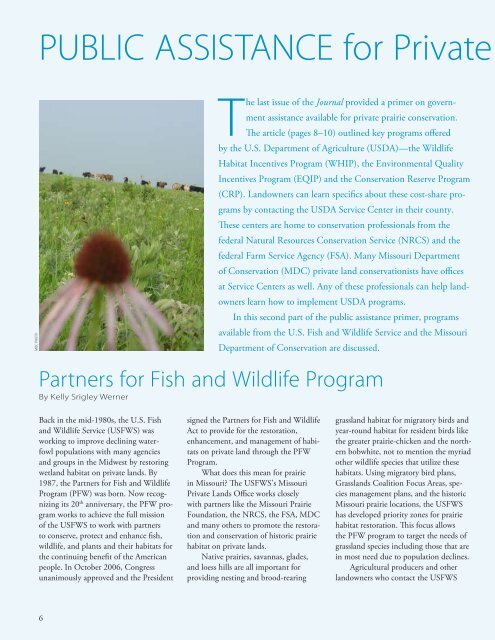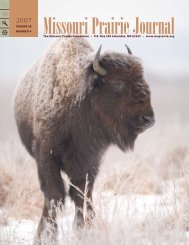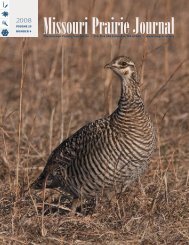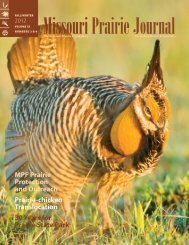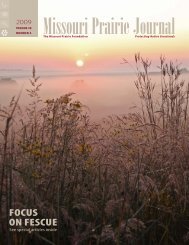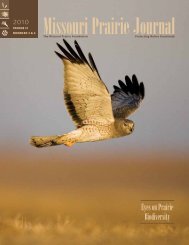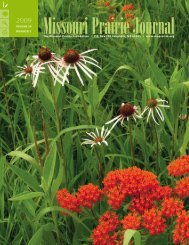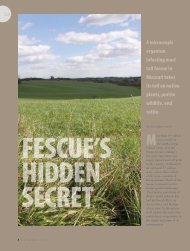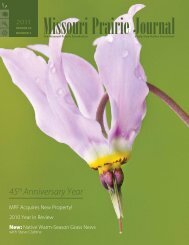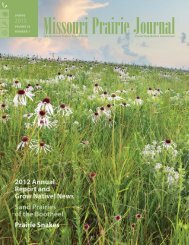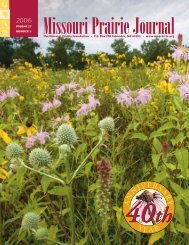Summer 2007: Volume 28, Number 3 - Missouri Prairie Foundation
Summer 2007: Volume 28, Number 3 - Missouri Prairie Foundation
Summer 2007: Volume 28, Number 3 - Missouri Prairie Foundation
- No tags were found...
Create successful ePaper yourself
Turn your PDF publications into a flip-book with our unique Google optimized e-Paper software.
Public Assistance for Privatemdc photoThe last issue of the Journal provided a primer on governmentassistance available for private prairie conservation.The article (pages 8–10) outlined key programs offeredby the U.S. Department of Agriculture (USDA)—the WildlifeHabitat Incentives Program (WHIP), the Environmental QualityIncentives Program (EQIP) and the Conservation Reserve Program(CRP). Landowners can learn specifics about these cost-share programsby contacting the USDA Service Center in their county.These centers are home to conservation professionals from thefederal Natural Resources Conservation Service (NRCS) and thefederal Farm Service Agency (FSA). Many <strong>Missouri</strong> Departmentof Conservation (MDC) private land conservationists have officesat Service Centers as well. Any of these professionals can help landownerslearn how to implement USDA programs.In this second part of the public assistance primer, programsavailable from the U.S. Fish and Wildlife Service and the <strong>Missouri</strong>Department of Conservation are discussed.Partners for Fish and Wildlife ProgramBy Kelly Srigley WernerBack in the mid-1980s, the U.S. Fishand Wildlife Service (USFWS) wasworking to improve declining waterfowlpopulations with many agenciesand groups in the Midwest by restoringwetland habitat on private lands. By1987, the Partners for Fish and WildlifeProgram (PFW) was born. Now recognizingits 20 th anniversary, the PFW programworks to achieve the full missionof the USFWS to work with partnersto conserve, protect and enhance fish,wildlife, and plants and their habitats forthe continuing benefit of the Americanpeople. In October 2006, Congressunanimously approved and the Presidentsigned the Partners for Fish and WildlifeAct to provide for the restoration,enhancement, and management of habitatson private land through the PFWProgram.What does this mean for prairiein <strong>Missouri</strong>? The USFWS’s <strong>Missouri</strong>Private Lands Office works closelywith partners like the <strong>Missouri</strong> <strong>Prairie</strong><strong>Foundation</strong>, the NRCS, the FSA, MDCand many others to promote the restorationand conservation of historic prairiehabitat on private lands.Native prairies, savannas, glades,and loess hills are all important forproviding nesting and brood-rearinggrassland habitat for migratory birds andyear-round habitat for resident birds likethe greater prairie-chicken and the northernbobwhite, not to mention the myriadother wildlife species that utilize thesehabitats. Using migratory bird plans,Grasslands Coalition Focus Areas, speciesmanagement plans, and the historic<strong>Missouri</strong> prairie locations, the USFWShas developed priority zones for prairiehabitat restoration. This focus allowsthe PFW program to target the needs ofgrassland species including those that arein most need due to population declines.Agricultural producers and otherlandowners who contact the USFWS


